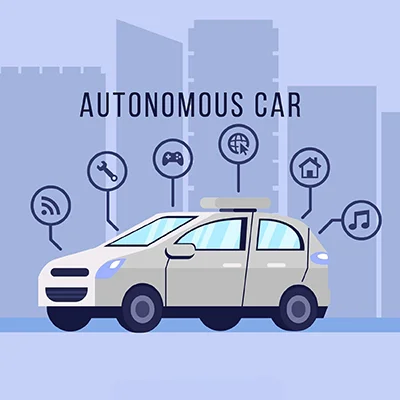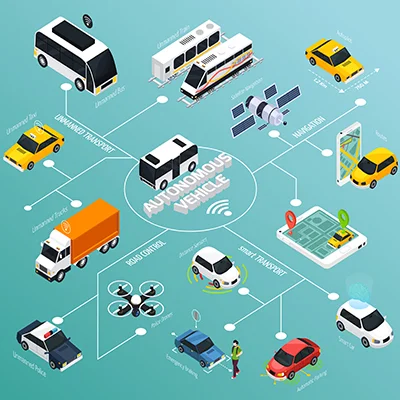Autonomous Vehicle: often referred to as a self-driving car or driverless car, is a type of vehicle equipped with advanced technologies and systems that allow it to operate and navigate without direct human intervention. These vehicles use a combination of sensors, cameras, radar, lidar, GPS, and sophisticated computer algorithms to perceive their environment, make real-time decisions, and control their movement on roads and highways.
History of Autonomous Vehicle
The history of autonomous vehicles is a fascinating journey that spans over a century of innovation and technological advancement. While the concept of self-driving cars has captured the imagination of scientists, engineers, and science fiction writers for many years, it wasn’t until recent decades that significant progress was made.
Here’s a brief overview of the key milestones in the history of autonomous vehicles:
- Early Concepts (1920s-1950s):
– The idea of autonomous vehicles can be traced back to the early 20th century when inventors and engineers began to envision self-driving cars.
– In the 1920s, the first experiments with radio-controlled vehicles took place, demonstrating remote control technology.
– In 1956, General Motors showcased the Firebird II concept car, which featured automated highway driving capabilities using electronic controls and guidance systems. - Stanford Cart (1960s):
– In the 1960s, researchers at Stanford University developed the Stanford Cart, an autonomous vehicle that could navigate indoors using sensors and cameras. - ALV and PROMETHEUS Projects (1980s):
– In the 1980s, Germany initiated the Autonomous Land Vehicle (ALV) project, which aimed to develop self-driving military vehicles.
– The European PROMETHEUS project also began in the 1980s, focusing on the development of autonomous driving technologies for civilian use. - DARPA Challenges (2000s):
– The U.S. Defense Advanced Research Projects Agency (DARPA) organized several Grand Challenges in the 2000s to stimulate autonomous vehicle development.
– The 2004 DARPA Grand Challenge was a 131.6-mile desert race for autonomous vehicles, with no vehicle completing the course. However, significant progress was made.
– In the 2005 DARPA Grand Challenge, five autonomous vehicles successfully completed a 132-mile course through the desert, showcasing substantial advancements in technology. - Google’s Self-Driving Car Project (2009):
– Google (now Alphabet Inc.) launched its self-driving car project in 2009, later spinning it off into a separate subsidiary called Waymo. This project was instrumental in popularizing autonomous vehicle technology. - Commercial Developments (2010s-Present):
– In the 2010s, numerous companies and automotive manufacturers began investing heavily in autonomous vehicle research and development.
– Tesla introduced its Autopilot feature, which offers advanced driver-assistance capabilities, although it still requires driver supervision.
– Waymo conducted extensive testing and launched a ride-hailing service with fully autonomous vehicles in Phoenix, Arizona.
– Traditional automakers like General Motors, Ford, and BMW also joined the race to develop autonomous vehicles. - Legislative and Regulatory Developments:
– Governments and regulatory bodies worldwide have been working on guidelines and regulations for autonomous vehicles to ensure safety and accountability. - Ongoing Research and Development:
– Autonomous vehicle technology continues to evolve, with advancements in artificial intelligence, sensor technology, and machine learning driving progress.
– Companies are exploring various applications, including autonomous trucks, delivery vehicles, and robo-taxis.
The history of autonomous vehicles is marked by steady progress, with self-driving technology becoming increasingly integrated into the future of transportation. While many challenges remain, including regulatory and safety considerations, the development of autonomous vehicles has the potential to revolutionize transportation, reduce accidents, and increase efficiency in the coming years.
Types of Autonomous Vehicle
Autonomous vehicles can be categorized into several types based on their intended use, design, and level of automation. The Society of Automotive Engineers (SAE) has established a widely recognized classification system for autonomous vehicles, which ranges from Level 0 (no automation) to Level 5 (full automation).
Here are the main types of autonomous vehicles based on this classification:
- Level 0 (No Automation):
– Level 0 vehicles have no automation features. All aspects of driving are controlled by the human driver. - Level 1 (Driver Assistance):
– Level 1 vehicles feature driver assistance systems that provide limited automation.
– Examples include adaptive cruise control, where the vehicle can maintain a set speed and adjust it to match the speed of the vehicle in front, and lane-keeping assistance, which helps keep the vehicle within its lane. - Level 2 (Partial Automation):
– Level 2 vehicles offer a higher level of automation but still require constant driver supervision.
– These vehicles can simultaneously control both steering and acceleration/deceleration functions.
– Tesla’s Autopilot system is an example of Level 2 automation. - Level 3 (Conditional Automation):
– Level 3 vehicles are capable of handling some driving tasks autonomously but may require the driver to take over when requested by the system.
– The vehicle can manage most aspects of driving under specific conditions, such as highway driving.
– Audi’s Traffic Jam Pilot is an example of Level 3 automation. - Level 4 (High Automation):
– Level 4 vehicles can perform most driving tasks without human intervention in specific environments or scenarios.
– These vehicles are designed for autonomous operation within predefined areas or situations, such as urban zones or dedicated self-driving taxi services. - Level 5 (Full Automation):
– Level 5 vehicles are fully autonomous and capable of performing all driving tasks under all conditions without any human involvement.
– There is no need for a steering wheel or pedals in Level 5 vehicles.
– Level 5 autonomy represents the highest level of automation and is often associated with futuristic visions of self-driving cars. - Specialized Autonomous Vehicles:
– In addition to the SAE levels, there are specialized autonomous vehicles designed for specific purposes, such as autonomous trucks for long-haul freight transportation, autonomous shuttles for public transportation in controlled environments, and autonomous delivery vehicles for last-mile logistics.
It’s important to note that the development and deployment of autonomous vehicles are ongoing, and the industry is continually evolving. Regulations and standards may vary by region, and the adoption of autonomous technology is expected to progress gradually, with Level 5 automation remaining a long-term goal for many companies in the autonomous vehicle space.

Benefits of Autonomous Vehicle
Autonomous vehicles offer a wide range of potential benefits, which have the potential to significantly impact various aspects of society and the economy.
Here are some of the key benefits of autonomous vehicles:
- Improved Safety:
– Autonomous vehicles have the potential to reduce accidents caused by human errors, such as distracted driving, impaired driving, and speeding. Advanced sensors and algorithms can react faster and more predictably than humans. - Reduced Traffic Congestion:
– Autonomous vehicles can communicate with each other and traffic infrastructure, enabling smoother traffic flow and reduced congestion. They can optimize speed and spacing, leading to less stop-and-go traffic. - Increased Mobility for Vulnerable Populations:
– Autonomous vehicles can provide greater mobility options for individuals with disabilities, the elderly, and those who cannot drive due to medical conditions, increasing their independence. - Enhanced Fuel Efficiency:
– Autonomous vehicles can optimize driving patterns, such as acceleration and braking, to improve fuel efficiency, leading to reduced fuel consumption and lower emissions. - Time Savings:
– Passengers in autonomous vehicles can use their travel time more productively, whether for work, relaxation, or entertainment, as they no longer need to focus on driving. - Reduced Parking Demand:
– Autonomous vehicles can drop passengers off at their destination and then find parking spaces on their own, reducing the need for large parking facilities and potentially freeing up urban space for other uses. - Improved Transportation Access:
– Autonomous ride-sharing services could provide affordable and convenient transportation options, particularly in underserved areas with limited public transportation infrastructure. - Increased Road Capacity:
– Autonomous vehicles can safely operate at closer following distances, which can increase the capacity of existing road infrastructure without the need for costly expansions. - Lower Transportation Costs:
– The use of autonomous vehicles for ride-sharing and transportation-as-a-service models could reduce the overall cost of transportation for individuals by eliminating the need for vehicle ownership, fuel, and maintenance. - Environmental Benefits:
– By optimizing driving patterns and reducing congestion, autonomous vehicles can contribute to lower greenhouse gas emissions and air pollution. - Reduced Traffic Accidents and Costs:
– Fewer accidents and improved safety can result in lower healthcare costs, insurance premiums, and vehicle repair costs. - Economic Opportunities:
– The development and deployment of autonomous vehicles can create new industries and job opportunities in areas such as software development, vehicle manufacturing, and maintenance. - Enhanced Public Transportation:
– Autonomous shuttles and buses can improve the efficiency and accessibility of public transportation, potentially increasing ridership and reducing the number of private vehicles on the road.
It’s important to note that while autonomous vehicles offer many potential benefits, there are also challenges and concerns to address, including regulatory and safety issues, infrastructure upgrades, cybersecurity, and the impact on employment in certain industries. Realizing these benefits will require careful planning, collaboration between stakeholders, and ongoing research and development.
Facts of Autonomous Vehicle
Autonomous vehicles, also known as self-driving cars or driverless cars, are a rapidly advancing technology with many fascinating facts and aspects.
Here are some interesting facts about autonomous vehicles:
- Long History: The concept of autonomous vehicles dates back to the early 20th century, with early experiments in radio-controlled cars. However, it’s only in recent decades that significant progress has been made.
- Alphabet’s Waymo: Waymo, a subsidiary of Alphabet Inc. (formerly Google), is one of the pioneers in autonomous vehicles. Waymo’s self-driving cars have logged millions of miles in real-world testing.
- Lidar Technology: Many autonomous vehicles rely on Lidar (Light Detection and Ranging) technology, which uses laser beams to create detailed 3D maps of the surroundings. Lidar helps vehicles “see” the road and objects around them.
- AI and Machine Learning: Autonomous vehicles use artificial intelligence and machine learning algorithms to process sensor data, make driving decisions, and improve their performance over time.
- Tesla Autopilot: Tesla’s Autopilot system offers advanced driver-assistance features. While not fully autonomous, it can handle tasks like lane-keeping and adaptive cruise control.
- Different Levels of Autonomy: The Society of Automotive Engineers (SAE) has defined six levels of autonomy, ranging from Level 0 (no automation) to Level 5 (full automation). Most vehicles on the road today fall into Levels 1 and 2.
- Autonomous Trucking: Besides passenger cars, autonomous technology is being developed for trucks. Self-driving trucks have the potential to revolutionize the logistics and shipping industries.
- Safety Benefits: One of the primary motivations for autonomous vehicles is safety. Self-driving cars have the potential to reduce accidents caused by human error, which is a leading cause of traffic fatalities.
- Ride-Hailing Services: Companies like Uber and Lyft are investing in autonomous technology for ride-hailing services. In the future, you might order a ride, and a driverless car will pick you up.
- Regulatory Challenges: Developing regulations for autonomous vehicles is a complex and ongoing process. Governments worldwide are working on standards to ensure safety and accountability.
- Cybersecurity Concerns: As vehicles become more connected and reliant on software, there are growing concerns about cybersecurity and the potential for hacking of autonomous vehicles.
- Ethical Dilemmas: Autonomous vehicles sometimes face moral dilemmas, such as how to prioritize the safety of occupants versus pedestrians in emergency situations. These are challenging ethical questions to address.
- Environmental Impact: While autonomous vehicles have the potential to improve fuel efficiency and reduce emissions through optimized driving, they may also lead to more vehicle miles traveled if people use them for longer commutes or additional trips.
- Economic Disruption: The widespread adoption of autonomous vehicles could disrupt various industries, including taxi services, trucking, and auto insurance.
- Continuous Advancements: Autonomous vehicle technology is advancing rapidly, with ongoing research, development, and testing by various companies and research institutions worldwide.
These facts showcase the multifaceted nature of autonomous vehicles and the significant impact they can have on transportation, safety, and society as a whole.

What is the speed of autonomous vehicles?
The speed of autonomous vehicles can vary widely depending on their design, purpose, and the specific technology used. Autonomous vehicles are typically designed to operate at speeds that are consistent with the legal speed limits of the roads and highways on which they are intended to be used.
Here are some general considerations:
- Road Speed Limits: Autonomous vehicles are programmed to obey posted speed limits and traffic laws. They are designed to operate safely within the speed limits imposed by the local jurisdiction.
- Highway Speeds: On highways and expressways, many autonomous vehicles are capable of traveling at high speeds, often matching the legal speed limits, which can range from 55 mph (88 km/h) to 75 mph (120 km/h) or more in some regions.
- Urban and Residential Areas: In urban and residential areas, autonomous vehicles typically travel at lower speeds, often below 30 mph (48 km/h), to ensure the safety of pedestrians and other road users.
- Adaptive Speed Control: Some autonomous vehicles are equipped with adaptive cruise control, which allows them to automatically adjust their speed to maintain a safe following distance from the vehicle in front. This means they can slow down in traffic and accelerate when the road is clear.
- Specialized Autonomous Vehicles: There are specialized autonomous vehicles designed for specific purposes, such as autonomous trucks for long-haul freight transportation. These vehicles may have varying speed capabilities depending on their intended use.
It’s important to note that the speed of autonomous vehicles is not limited by technology, but rather by safety considerations and adherence to local traffic laws and regulations. Autonomous vehicles are designed to prioritize safety and obey speed limits to prevent accidents and ensure a smooth integration into existing traffic systems.
Additionally, the development and deployment of autonomous vehicles are ongoing, and future advancements may result in vehicles that can safely and efficiently operate at higher speeds when appropriate and in compliance with local regulations.
What is the future impact of autonomous vehicles?
The future impact of autonomous vehicles is expected to be far-reaching and transformative, affecting various aspects of society, the economy, and transportation. While the full realization of these impacts will depend on a range of factors, including technology development, regulatory decisions, and societal acceptance,
Here are some of the anticipated future impacts of autonomous vehicles:
- Improved Safety: Autonomous vehicles have the potential to significantly reduce accidents caused by human error, which is a leading cause of traffic fatalities. By consistently following traffic laws and utilizing advanced sensors and algorithms, self-driving cars can make driving safer for everyone on the road.
- Reduced Traffic Congestion: Autonomous vehicles can communicate with each other and traffic infrastructure, leading to smoother traffic flow and reduced congestion. They can optimize speed and spacing, potentially reducing the time people spend in traffic.
- Increased Mobility Access: Autonomous vehicles can provide greater mobility options for individuals who cannot drive due to disabilities, age, or other factors. This can improve access to education, employment, healthcare, and social activities.
- Transportation as a Service (TaaS): Autonomous ride-sharing and ride-hailing services are expected to become more prevalent, reducing the need for private vehicle ownership. People may subscribe to transportation services instead of buying cars, leading to cost savings for consumers.
- Economic Impact: The development and deployment of autonomous vehicles can create new industries and job opportunities in areas such as software development, vehicle manufacturing, and maintenance. At the same time, it may disrupt traditional industries like taxi services and long-haul trucking.
- Energy Efficiency and Environmental Benefits: Autonomous vehicles can optimize driving patterns and reduce fuel consumption, contributing to lower greenhouse gas emissions and reduced air pollution. Electric autonomous vehicles can further reduce their environmental footprint.
- Urban Planning and Infrastructure: The widespread adoption of autonomous vehicles may lead to changes in urban planning and infrastructure design. Cities may repurpose parking spaces for green areas, expand public transportation options, and redesign roadways to accommodate autonomous vehicles.
- Rural and Underserved Areas: Autonomous vehicles can improve transportation options in rural and underserved areas where public transportation is limited. This can enhance access to essential services and reduce isolation.
- Data and Connectivity: Autonomous vehicles generate vast amounts of data, which can be used for various purposes, including traffic management, predictive maintenance, and improving navigation systems.
- Cybersecurity Challenges: As vehicles become more connected and reliant on software, there are growing concerns about cybersecurity and the potential for hacking. Protecting autonomous vehicle systems from cyber threats will be a critical focus in the future.
- Regulatory and Legal Considerations: Governments and regulatory bodies are working on guidelines and regulations for autonomous vehicles to ensure safety and accountability. Legal frameworks and liability issues will continue to evolve.
- Ethical Dilemmas: Autonomous vehicles sometimes face ethical dilemmas, such as how to prioritize the safety of occupants versus pedestrians in emergency situations. Addressing these ethical questions is a complex challenge.
The future impact of autonomous vehicles will be shaped by ongoing developments in technology, regulatory decisions, consumer acceptance, and societal adaptation. While there are many potential benefits, there are also challenges to address, and the transition to a world with widespread autonomous vehicle use will likely be gradual and require careful planning and coordination.
Internet of Things: (IoT) Benefits & Building The Urban Future
Cloud Computing: Definition, Types, Scope, & Benefits





